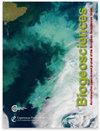Anthropogenic activities significantly increase annual greenhouse gas (GHG) fluxes from temperate headwater streams in Germany
IF 3.9
2区 地球科学
Q1 ECOLOGY
引用次数: 1
Abstract
Abstract. Anthropogenic activities increase the contributions of inland waters to global greenhouse gas (GHG; CO2, CH4, and N2O) budgets, yet the mechanisms driving these increases are still not well constrained. In this study, we quantified year-long GHG concentrations, fluxes, and water physico-chemical variables from 28 sites contrasted by land use across five headwater catchments in Germany. Based on linear mixed-effects models, we showed that land use was more significant than seasonality in controlling the intra-annual variability of the GHGs. Streams in agriculture-dominated catchments or with wastewater inflows had up to 10 times higher daily CO2, CH4, and N2O emissions and were also more temporally variable (CV > 55 %) than forested streams. Our findings also suggested that nutrient, labile carbon, and dissolved GHG inputs from the agricultural and settlement areas may have supported these hotspots and hot-moments of fluvial GHG emissions. Overall, the annual emission from anthropogenic-influenced streams in CO2 equivalents was up to 20 times higher (∼ 71 kg CO2 m−2 yr−1) than from natural streams (∼ 3 kg CO2 m−2 yr−1), with CO2 accounting for up to 81 % of these annual emissions, while N2O and CH4 accounted for up to 18 % and 7 %, respectively. The positive influence of anthropogenic activities on fluvial GHG emissions also resulted in a breakdown of the expected declining trends of fluvial GHG emissions with stream size. Therefore, future studies should focus on anthropogenically perturbed streams, as their GHG emissions are much more variable in space and time and can potentially introduce the largest uncertainties to fluvial GHG estimates.人为活动显著增加了德国温带水源溪流的年温室气体通量
摘要人为活动增加了内陆水域对全球温室气体(GHG)的贡献;CO2、CH4和N2O)的预算,但驱动这些增加的机制仍然没有得到很好的约束。在这项研究中,我们量化了28个地点全年的温室气体浓度、通量和水物理化学变量,并与德国五个水源集水区的土地利用进行了对比。基于线性混合效应模型的研究表明,土地利用对温室气体年际变率的控制比季节性更为显著。在以农业为主的集水区或有废水流入的河流中,二氧化碳、甲烷和氧化亚氮的日排放量高达10倍,而且与森林河流相比,它们的时间变化更大(CV值为55%)。我们的研究结果还表明,来自农业和定居地区的养分、不稳定碳和溶解的温室气体输入可能支持了这些河流温室气体排放的热点和热点时刻。总体而言,受人为影响的河流的年排放量(CO2当量为~ 71 kg CO2 m−2 yr−1)比自然河流的年排放量(~ 3 kg CO2 m−2 yr−1)高出20倍,其中CO2占年排放量的81%,而en2o和CH4分别占18%和7%。人类活动对河流温室气体排放的积极影响也导致河流温室气体排放量随河流大小的预期下降趋势被打破。因此,未来的研究应该集中在人为干扰的河流上,因为它们的温室气体排放在空间和时间上的变化更大,并且可能给河流温室气体估算带来最大的不确定性。
本文章由计算机程序翻译,如有差异,请以英文原文为准。
求助全文
约1分钟内获得全文
求助全文
来源期刊

Biogeosciences
环境科学-地球科学综合
CiteScore
8.60
自引率
8.20%
发文量
258
审稿时长
4.2 months
期刊介绍:
Biogeosciences (BG) is an international scientific journal dedicated to the publication and discussion of research articles, short communications and review papers on all aspects of the interactions between the biological, chemical and physical processes in terrestrial or extraterrestrial life with the geosphere, hydrosphere and atmosphere. The objective of the journal is to cut across the boundaries of established sciences and achieve an interdisciplinary view of these interactions. Experimental, conceptual and modelling approaches are welcome.
 求助内容:
求助内容: 应助结果提醒方式:
应助结果提醒方式:


